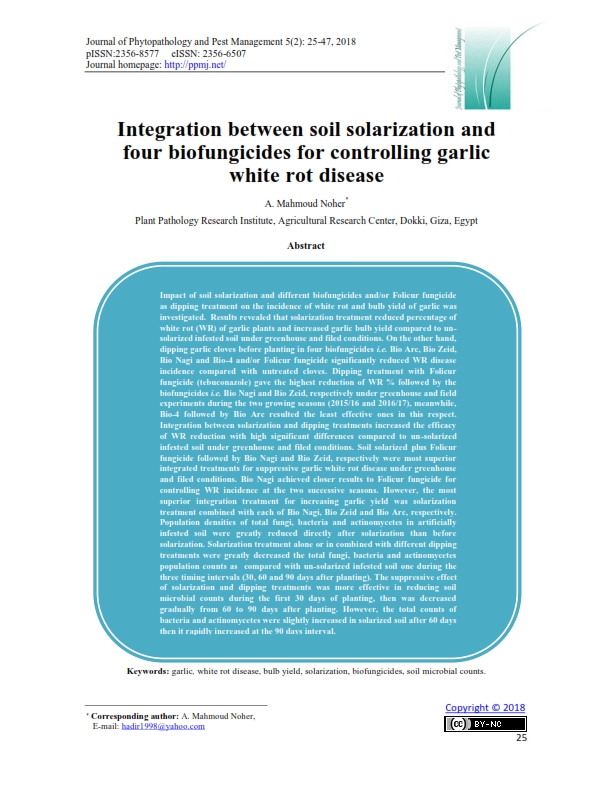Integration between soil solarization and four biofungicides for controlling garlic white rot disease
Keywords:
garlic, white rot disease, bulb yield, solarization, biofungicides, soil microbial counts.Abstract
Impact of soil solarization and different biofungicides and/or Folicur fungicide as dipping treatment on the incidence of white rot and bulb yield of garlic was investigated. Results revealed that solarization treatment reduced percentage of white rot (WR) of garlic plants and increased garlic bulb yield compared to un-solarized infested soil under greenhouse and filed conditions. On the other hand, dipping garlic cloves before planting in four biofungicides i.e. Bio Arc, Bio Zeid, Bio Nagi and Bio-4 and/or Folicur fungicide significantly reduced WR disease incidence compared with untreated cloves. Dipping treatment with Folicur fungicide (tebuconazole) gave the highest reduction of WR % followed by the biofungicides i.e. Bio Nagi and Bio Zeid, respectively under greenhouse and field experiments during the two growing seasons (2015/16 and 2016/17), meanwhile, Bio-4 followed by Bio Arc resulted the least effective ones in this respect. Integration between solarization and dipping treatments increased the efficacy of WR reduction with high significant differences compared to un-solarized infested soil under greenhouse and filed conditions. Soil solarized plus Folicur fungicide followed by Bio Nagi and Bio Zeid, respectively were most superior integrated treatments for suppressive garlic white rot disease under greenhouse and filed conditions. Bio Nagi achieved closer results to Folicur fungicide for controlling WR incidence at the two successive seasons. However, the most superior integration treatment for increasing garlic yield was solarization treatment combined with each of Bio Nagi, Bio Zeid and Bio Arc, respectively. Population densities of total fungi, bacteria and actinomycetes in artificially infested soil were greatly reduced directly after solarization than before solarization. Solarization treatment alone or in combined with different dipping treatments were greatly decreased the total fungi, bacteria and actinomycetes population counts as compared with un-solarized infested soil one during the three timing intervals (30, 60 and 90 days after planting). The suppressive effect of solarization and dipping treatments was more effective in reducing soil microbial counts during the first 30 days of planting, then was decreased gradually from 60 to 90 days after planting. However, the total counts of bacteria and actinomycetes were slightly increased in solarized soil after 60 days then it rapidly increased at the 90 days interval.
Metrics

Published
How to Cite
Issue
Section
License
Authors who publish with Journal of Phytopathology and Disease Management agree to the following terms:
- Authors retain copyright and grant the journal right of first publication with the work simultaneously licensed under a Creative Commons Attribution License that allows others to share the work with an acknowledgement of the work's authorship and initial publication in this journal.
- Authors retain copyright and grant the journal right of first publication with the work simultaneously licensed under the Creative Commons Attribution-Non Commercial License (CC BY-NC). This allows others to share the work with an acknowledgement of the work's authorship and initial publication in this journal.
- Archives of Agricultural Sciences Journal is an Open Access Journal, and articles published are distributed under the terms of the Creative Commons Attribution-Non Commercial License (CC BY-NC). Readers may copy, distribute, and display the work for non commercial purposes with the proper citation of the original work. However, the journal retains the right to exploit subsidiary rights on behalf of the authors.
- Authors are able to enter into separate, additional contractural arrangements for the non-exclusive distribution of the journal's published version of the work (e.g. post it to an institutional repository or publish it in a book), with an acknowledgement of its initial publication in this journal.
- Authors are permitted and encouraged to post their work online (e.g., in institutional repositories or on their website) prior to and during the submission process with full disclosure to the journal, as it can lead to productive exchanges, as well as earlier and greater citation of published work. Following publication in Archives of Agricultural Sciences Journal, the author should update the repository, and include a citation and link to the published work.
Click here for more information on Licensing policy
.png)




